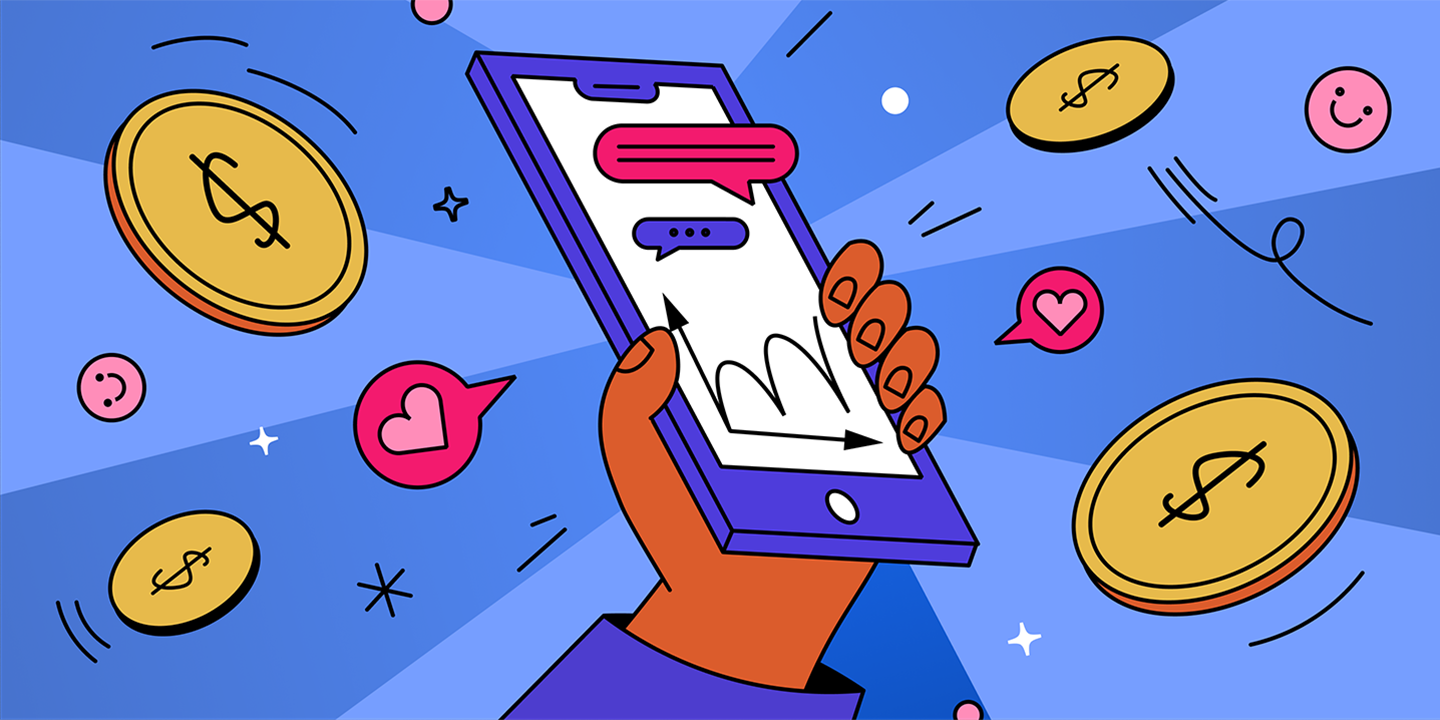Earned media, a powerful and influential aspect of public relations, is often misunderstood despite its profound impact on brand reputation and reach. It's the kind of publicity you don't pay for directly, but it's invaluable in building credibility and boosting your brand's visibility.
In this article, we delve into earned media meaning, the concept of earned media, how to get earned media, and explore its distinct benefits. Here's what you can expect:
- What is earned media?
- Benefits of earned media in Public Relations
- Successful earned media campaign examples
- Earned media strategies to get you started
- How to track & measure earned media
Try Prowly's media monitoring free for 7 days
Start tracking your earned media—monitor sentiment, brand mentions, and keywords across every major channel for free.
- Comprehensive monitoring: Track the web, social media, print, and broadcast mentions
- Transparent pricing: Plans start at $258/month
- All-in-one platform: Get everything you need in one tool for PR, incl. media database, outreach, reporting, and more
What is earned media?
Earned media, also known as organic visibility, refers to the exposure your business receives through non-paid sources. It stands in contrast to paid media, where you invest financially for guaranteed brand placement, such as in paid social media ads, billboards, podcast endorsements, or website banner ads.
Additionally, it differs from owned media, which includes channels you have full control over, like your website and blog. Shared media, on the other hand, encompasses the content you post on your social media accounts, excluding organic mentions or shares from others — that's where earned media comes into play.
In summary, earned vs unearned media:
- Earned media: Visibility gained organically.
- Paid media: Traditional advertising with financial investment.
- Owned media: Channels under your complete control.
- Shared media: Content posted on your social media accounts.
PR earned media is all about the reputation you build, the word-of-mouth buzz you generate. It's not something you create or pay for directly. What sets it apart is that it comes from independent sources, giving it some special advantages. In a nutshell, earned media is all about the power of others spreading the word about your brand!
What are examples of earned media?
Recognizing various types of earned media can help you understand what strategies might work best for your brand. Here are some common examples, each offering unique benefits:
- Press coverage: When your brand is mentioned in a news article or blog post, it's a form of earned media. This kind of publicity, often achieved through successful press releases or news-worthy events, can greatly enhance your brand's visibility and credibility.
- Social media mentions: Social media is a powerful platform for earned media. When users share your content or mention your brand, it increases brand awareness, reach, and engagement. Consistently publishing high-quality thought leadership blog posts and sharing them across social media channels is a proven method of earning social media mentions.
- Influencer partnerships: When influencers voluntarily endorse or mention your product, it's earned media. Influencers have a significant impact due to their large follower base, and their endorsements can be incredibly beneficial for your brand.
- Reviews and testimonials: Positive reviews and testimonials from satisfied customers can serve as potent earned media. This feedback, often shared on review platforms or social media, can boost your brand's reputation and trustworthiness.
In each case, public relations earned media is the result of organic and voluntary actions taken by independent individuals or entities, making it a highly trusted and credible form of publicity.
P. S. Discover more ideas and inspiration by exploring this guide to brand awareness campaigns, complete with examples to spark your creativity.
Benefits of earned media in Public Relations
1️⃣ Building credibility
Genuine information about your product or services coming from a third party feels more like a friend's recommendation — as opposed to a straightforward ad. If any material comes from you directly or is marked as sponsored, there's always a pinch of caution.
Your readers expect you to be biased and therefore try to find more impartial info on Google or in relevant offline media. And it’s here that PR activities can bring you earned media — and more credible sources for your potential clients.
P.S. This effect is even stronger since influencers have to distinguish which of their recommendations are sponsored by a company and which are not. If you're lucky to get an earned mention there — congrats!
2️⃣ Increasing brand visibility
Earned media helps you gain visibility for your brand exactly where you need it. However, it can bring you lower numbers, in terms of traffic, compared to the usual ads or sponsored articles in popular media. Fear not, though — the quality is usually higher.
The logic that stands behind this is simple: you get earned media from outlets that know their audience would be interested in your story.
Also, you can gain more visibility from search results. When your product or service is a part of "X best [category]," you're more likely to reach a new audience — as those posts often get the highest places in Google.
3️⃣ Establishing authority
Getting featured by reliable sources (even in niche communities) helps in positioning your brand as an authority. As they can't afford to lose their hard-gained reliability, they're usually cautious when it comes to sharing others' materials.
That's why when they finally share yours, your brand gets a share of that authority. When it appears across different, high-quality outlets, it all adds up and positions your brand as the industry's top voice.
4️⃣ Enhancing trust
Think about a scenario when you're about to buy a coffee machine. There's one option you like better, judging from their homepage, and another one that is okay, and backed by several (positive, of course) opinions across different sources. If the stakes are high, like with your money and the day-to-day comfort of making a good coffee, you'll probably go with a more popular — thus safer — choice.
Enhancing trust is the direct benefit of earned media.
When your brand appears in multiple, reliable places, like services with verified reviews, bloggers specialized in a given industry, or YouTube reviews, it's a sign to your potential customers that they can trust you.
5️⃣ Cost-effectiveness
What does earned media mean for business? The placements are free, which, compared to regular ads, helps you save on budget. That's what can convince the board to give it a go.
There's an important note, though. Even though you don't pay for the placement, you still need to invest to get earned media opportunities. For example, by pouring your time into PR activities and using tools that support them.
Nevertheless, it's still worth it. A well-executed earned media plan can bring you immense results and support the brand's paid marketing actions.
Why do others let you earn media?
When you look at it from just the brand perspective, it's all just too good to be true: getting free ads and multiple benefits for a bit of extra effort. Yet, it's a mutual exchange: you give them something valuable to talk about (basically, content for their channels), and they give you exposure.
Let's start with an extreme earned media example. Some people, events, brands or institutions are just news worthy — anything they do or say instantly appears in multiple places. Think Elon Musk, the Super Bowl, or Google. The most important voices in the industry are eager to comment on each.
Even if you're not in this club (like most of us), there are still a lot of people willing to share your story. And you can reach them with smart PR activities.
Successful earned media campaign examples
Earned media example: Red Bull Stratos

After all these years, it still makes for one of the best earned media campaigns.
In 2012, Felix Baumgartner, an Austrian skydiver, broke the sound barrier as the first person to do so without any form of engine power, jumping from almost 40 000 m (over 130 000 feet).
This impressive project translated into equally huge PR numbers. As Red Bull claims on their site, the event was watched live by 8 million people (when they expected 2-3 mln). It also generated 100 million playbacks on YouTube in the first weeks after the jump, adding up to almost a billion 10 years later.
This Red Bull example is enormous, yet it stays in line with the company's vision to break human limitations. When you find an equivalent for your brand and industry, it'll make the news — even if on a smaller scale.
Earned media example: Tesla Roadster launched in Space
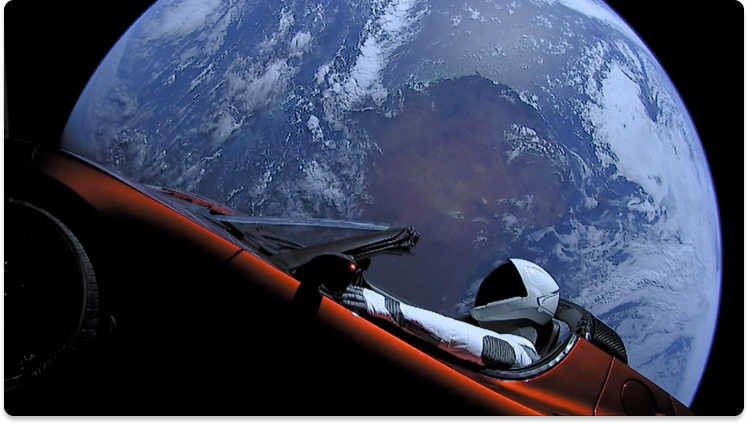
It could have been just another test flight of Falcon Heavy in 2018, but ended up as a widely-commented PR action. All it took was using a Tesla car as a dummy payload. You might not expect it, but the idea of launching a Tesla came from Twitter users — which creates a perfect example of engaging your audience.
The point here is simple: you can turn a relatively boring event into huge news. And get earned media.
Earned media example: Spotify Wrapped
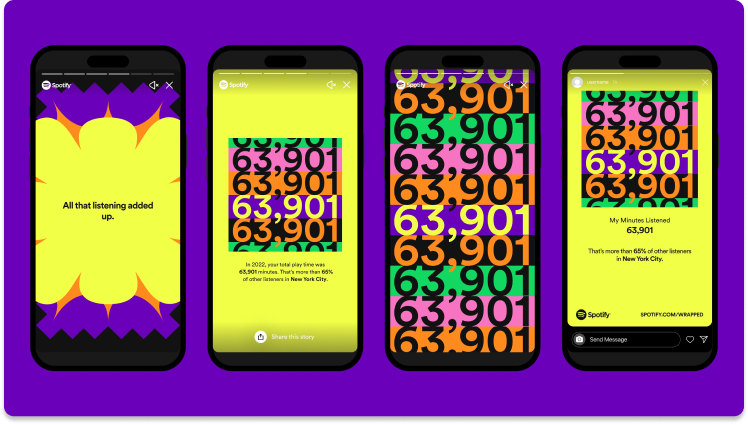
Let's get back to Earth with the yearly evaluation of our genuine music tastes — Spotify Wrapped. The popular music streaming app picks the most interesting facts about each listener's preferences, like genres, songs, and artists, and compares them with its general audience.
It's prepared in an aesthetic, friendly, easy-to-share format, and lots of users decide to show their stats. When Wrapped was released, you could see Spotify literally everywhere.
The Spotify Wrapped campaign even got a Webby Award nomination in the "Best Use of Earned Media" category (in 2023).
The success of this campaign comes from two specific traits:
- it's all about the user
- it's data they probably want to (and can) share
And that, wrapped up in a pleasant way, is just the perfect shareable story.
And yet, put that in a different context (with sensitive personal or business data), and it won't catch on.
Earned media strategies to get you started
👉 Crafting compelling news stories
The value of stories you prepare for earned media purposes is the very foundation of your PR success. Period.
That said, let's talk about two ways in which you can ensure the highest quality for your stories.
The first one is the what, or the story itself that you cover. Be selective on what makes the shortlist for your earned media efforts. Spreading too thin can undermine your work. If you're known for pitching high-quality stories to journalists, it'll pay off in the long run.
The second is the how, how you present your stories to your audience — the people who might share them. Make sure they immediately see the value of your story (or the joke in your meme) so that they want to showcase it. Remember that it needs to align with their goals, like building an image as an industry expert, or keeping their status of being the funny one.
A traditional way to share your stories is with compelling press releases. This standardized format helps journalists create their pieces of content, containing all the most important data and useful visuals.
Here you will find 15 brand story examples to get inspired by.
👉 Nurturing connections with journalists
That's the second earned media tactic. PR departments with well-established relationships with journalists get more earned media coverage with less effort.
Nurturing professional relationships with journalists is a cornerstone of earned media in public relations. The media is your conduit to the public and journalists are the gatekeepers. Having a strong rapport with journalists can significantly increase the chances of your story getting picked up and featured. It creates an atmosphere of trust, making it more likely that a journalist will consider your press release when sourcing their stories.
Well-fostered relationships can result in more frequent and quality coverage, making your brand a credible source of information. Therefore, having a good network of journalists is not just beneficial, but essential to the success of your earned media strategy.
Prowly helps you find relevant journalists with just a few clicks. Read how in "How to Find Relevant Journalists & Their Emails to Contact Them".
👉 Getting broadcast and press coverage
Securing press coverage boosts visibility and credibility. Mentions in reputable media, whether online, print, TV, or radio, enhance your brand's prestige and reach. Effective coverage drives public interest, influences opinions, and supports business goals by attracting customers and investors.
With Prowly, you can monitor not only digital media mentions but also traditional ones, including newspapers, radio, TV, and increasingly popular podcasts.
That means you can:
- Instantly access global, national, and local newspapers, trade publications, magazines, and journals
- Track brand mentions, competitors, and industry trends across all print and paywalled outlets
- Easily analyze your results using customizable dashboards, complete with new filters that simplify evaluating the impact of your campaigns
- Ensure comprehensive coverage from diverse sources and evaluate print media investments and campaign ROI with advanced filters
P.S. Here's a whole article on how to use print monitoring in the digital PR world (with examples).
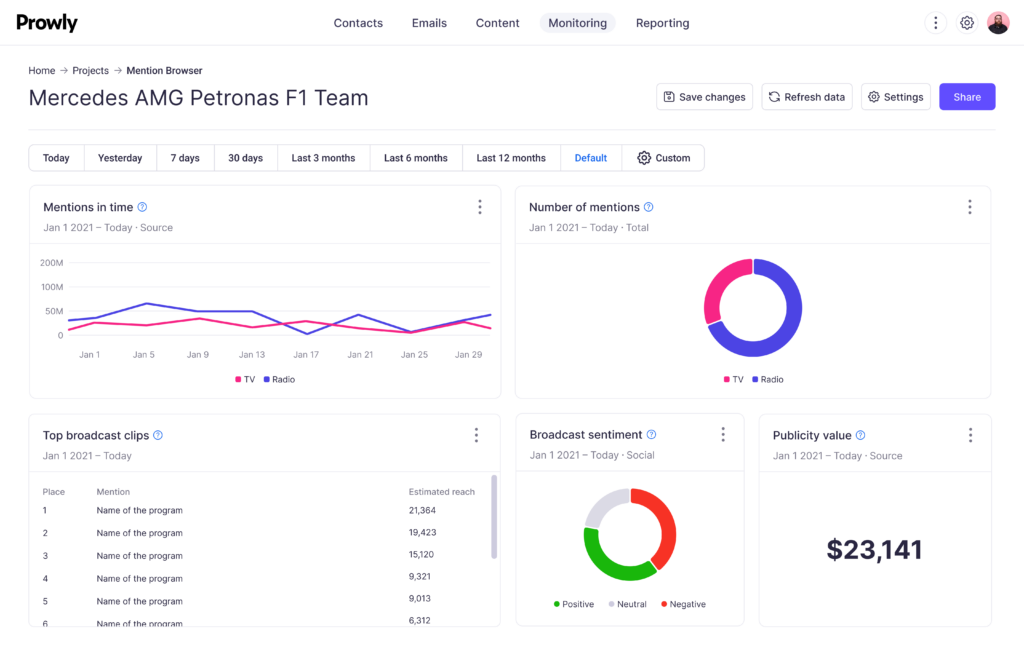
If you're interested in a customized plan that aligns with your specific goals, or if you want to add print and broadcast monitoring to your toolkit, simply provide your contact information, and we'll handle the rest.
👉 Harnessing the power of social proof
Social proof can add credibility and relevant context to your stories. When you can support your words with others' opinions, you essentially give stronger reasons to share your story. During earned media planning, analyze what stories can be enriched with gathered social proof.
👉 Encourage user-generated content
As a brand, you have a wide variety of incentives to get more content (and earned media) from your users. From discounts for an online review to competitions run on your social media, these perks can convince people to share their ideas and talk about your brand.
You can also encourage user-generated content without spending a dime. That's a topic we cover in an entire section below.
👉 Monitoring online conversations
Being online gives brands a new range of ways to engage with their customers, yet it's still — after all these years — undervalued. If you monitor the conversations taking place and jump in when appropriate: kudos! If not, we'll try to convince you it's worth your time.
By doing so, you're basically minimizing the distance between you as a brand and your customers. As long as it fits your strategy, it can bring tangible results in terms of brand loyalty.
It proves invaluable in generating additional earned media. By demonstrating a genuine interest in your customers' posts, videos, and other forms of expression, you communicate that their voices matter. This, in turn, encourages them to share more, resulting in a greater amount of earned media for your brand.
There's one more benefit to monitoring online conversations — it'll be way easier to prevent a PR crisis.
How to track & measure earned media
You can measure earned media reach with specialized tools, like Prowly's Media Monitoring. It essentially searches through the internet for keywords that you choose. With advanced filters and AI, you'll see only the relevant mentions, freeing up your time.

Willing to dig in deeper? Check out our guide on How to Do Media Monitoring: Tips & Best Practices and the most comprehensive guide we prepared on social listening and social media monitoring so far: The Complete Social Media Listening Guide for Public Relations.
It also provides you with sentiment, authority analysis, and calculated reach — tangible metrics to assess the impact of your earned media.
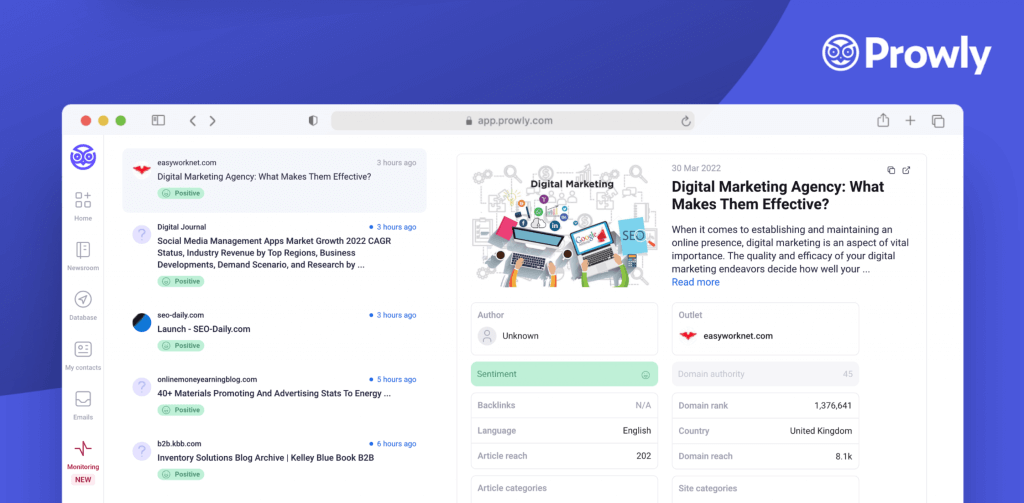
Conclusion
Spot-on earned media placements let you build trust and credibility in the eyes of your customers. As it's unpaid and genuine, it holds higher value than sponsored articles.
Even though you can't entirely control this channel, you can boost your chance of gaining the spotlight. When it happens, media monitoring lets you measure its impact and analyze its efficiency.
Hopefully, with this earned media guide, you'll be able to reap earned media benefits for your business.
